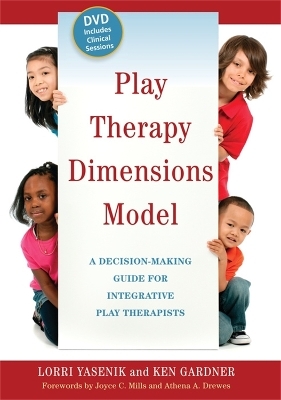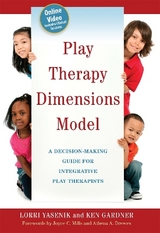
Play Therapy Dimensions Model
Jessica Kingsley Publishers (Verlag)
978-1-84905-296-2 (ISBN)
- Titel ist leider vergriffen;
keine Neuauflage - Artikel merken
With a wealth of practical and effective tools, this book provides a unique model that is fully illustrated by instructional DVD. The model allows therapists to tailor their approach to the specific needs of the child. Practitioners are encouraged to be engaged and flexible during sessions, adapting their levels of directiveness and consciousness according to the child's responses. Through detailed written and visual case studies, the authors clearly explain the model, how to use it and the positive therapeutic effects it can have on the child. The book also provides additional support to play therapy practitioners and play therapy supervisors with the inclusion of useful forms that aid therapy planning, conceptualization and evaluation.
This extensive and accessible handbook is an incomparable resource for beginning and seasoned play therapists, play therapy supervisors and instructors. It will also be of interest to child and educational psychologists and health professionals.
Lorri Yasenik and Ken Gardner are co-directors of the Rocky Mountain Play Therapy Institute in Calgary, Alberta, Canada, an accredited training institute founded in 1996 that offers experiential learning opportunities, integrating play therapy theory and practice. Lorri is a certified play therapist, and a founding member and former executive board member of the Alberta Play Therapy Association. She has presented nationally and internationally in the areas of play therapy, child psychotherapy, attachment, family violence, high conflict divorce and family mediation, and her PhD study is in the area of 'The Voice of the Child in Legal Matters'. Ken is a Clinical Psychologist and a Certified Play Therapy Supervisor. He is a past executive board member of the Canadian Association for Child Psychotherapy and Play Therapy, and has been a clinical practitioner for over 24 years. He is a former teacher of young children with special needs, and provides consultation to early intervention services as well as to therapists, schools, case managers and families. Ken has presented nationally and internationally on a wide range of topics related to play therapy and play-based interventions.
Acknowledgements. Foreword by Joyce C. Mills. Foreword to the Second Edition. 1. Introduction. Do play therapists need an organizing framework? Integrative Play Therapy: The Need for a Framework for Decision-Making. Play Therapy Dimensions Model: A Decision Guide for Integrative Play Therapists. How do Integrative Therapists Make Decisions? Do Decision-Making Theories designed for Adults fit for Play Therapists? What is the Play Therapy Dimensions Model? About this book. Case Studies. 2. Play Therapy Dimensions Model. The Two Dimensions. The Four Quadrants. Factors Related to Movement between Quadrants. Degree of reorganization.: The child process. Level of therapist interpretation. 3. The Consciousness Dimension in Play Therapy. What's so mysterious about consciousness? Historical and current Perspectives. Are we playing a game of hide-and-seek? Learning to embrace the game of hide-and-seek. 4 The Directiveness Dimension in Play Therapy. So, what kind of therapist are you? The compass and the gauge. The observer-participant role. Tapping the therapeutic powers of play. 5. Quadrant III: Non-Intrusive Responding. The What: The Defining Features of Quadrant III. The How: Therapeutic Roles and Activities. Illustrative Case Study: DVD Segment - Ellis. The When: Considerations for the Play Therapy Process. The Who: Clinical Applications. Should I Stay, or Should I Go? Indications for Working in Quadrant III. Illustrative Case Study: Haley. 6. Quadrant IV: Co-facilitating. The What: The Defining Features of Quadrant IV. The How: Therapeutic Roles and Activities. Illustrative Case Study: DVD Quadrant IV Segment - Ellis. The When: Considerations for the Play Therapy Process. The Who: Clinical Applications. Should I Stay, or Should I Go? Indications for Working in Quadrant IV. Illustrative Case Study: Haley. 7. Quadrant I: Active Utilization. The What: The Defining Features of Quadrant I. Illustrative Case Study: DVD Quadrant I Segment - Ellis. The How: Therapeutic Roles and Activities. The When: Considerations for the Play Therapy Process. The Who: Clinical Applications. Should I Stay, or Should I Go? Indications for Working in Quadrant I. Illustrative Case Study: Haley. 8. Quadrant II: Open Discussion and Exploration. The What: The Defining Features of Quadrant II. Illustrative Case Study: DVD Quadrant II Segment - Ellis. The When: Considerations for the Play Therapy Process. The Who: Clinical Applications. Should I Stay, or Should I Go? Indications for Working in Quadrant II. Illustrative Case Study: Haley. 9. Utilizing the Play Therapy Dimensions Model. Why we use the Play Therapy Dimensions Model for Supervision. How to Use the DVD. Aiding Supervisees to use Videos/Video review. Use the Play Therapy Dimensions Model to Review Videos. A Developmental Model of Supervision. Utilizing the Tracking and. Observations Form. Utilizing the Child and Therapist. Moderating Factors Scale. Utilizing the Degree of Immersion: Therapist Use of Self Scale. 10. Therapist Use of Self. What are we looking for? Use of Self: Verbal Discussion. Use of Self: Reflective Statements. Use of Self: Emotionality. Use of Self: Physical Self. Use of Self: Interpretations. Summary. 11. Setting the Compass: The Journey to Self-Awareness. Playtime: Know yourself as a player. Know Yourself and Your Temperament. Know Yourself Culturally and Ethnically. Know Yourself When Working with Parents. Making Meaning. 12. Three Influences: The Experts, the Children and the Students. Future Directions. Appendix A: Child and Therapist Moderating Factors Scale. Appendix B: Degree of Immersion. Appendix C: Play Therapy Dimensions Model. Appendix D: Playtime Exercise. References. About the Authors. Subject Index. Author Index.
| Vorwort | Joyce C. Mills, Athena A. Drewes |
|---|---|
| Zusatzinfo | 3 black and white illustrations |
| Verlagsort | London |
| Sprache | englisch |
| Maße | 176 x 245 mm |
| Gewicht | 474 g |
| Themenwelt | Geisteswissenschaften ► Psychologie ► Entwicklungspsychologie |
| Medizin / Pharmazie ► Medizinische Fachgebiete ► Psychiatrie / Psychotherapie | |
| Medizin / Pharmazie ► Physiotherapie / Ergotherapie ► Ergotherapie | |
| ISBN-10 | 1-84905-296-4 / 1849052964 |
| ISBN-13 | 978-1-84905-296-2 / 9781849052962 |
| Zustand | Neuware |
| Haben Sie eine Frage zum Produkt? |
aus dem Bereich



